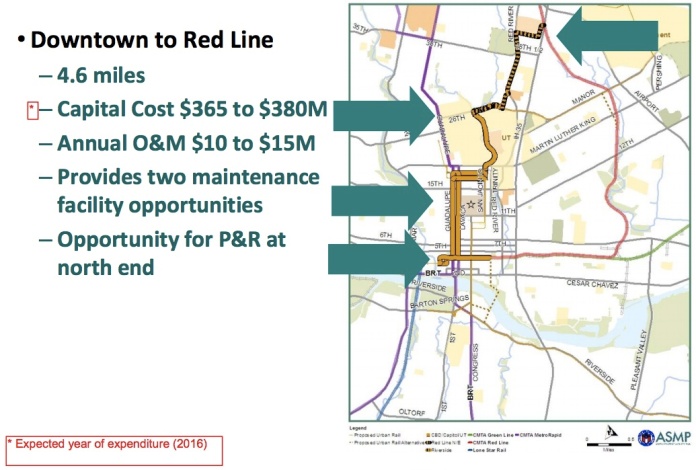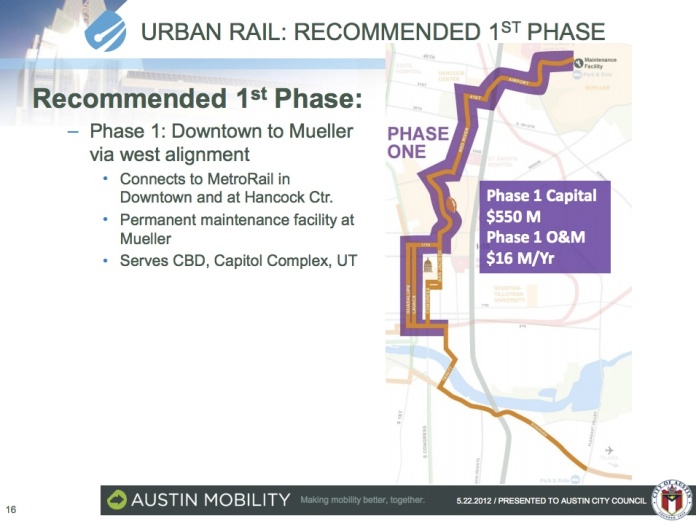Later today, Project Connect will likely present the Mayor and the Central Corridor Advisory Group with two basic alignment options for the urban rail project; one that crosses the lake and one that does not. Today’s meeting will move Austin closer to choosing the final proposal that will be presented to voters in November of this year.
The Two Options
Project Connect will likely present an alignment option that goes from downtown, up the San Jacinto/Trinity couplet (or perhaps the Guadalupe/Lavaca couplet), through the University of Texas on San Jacinto, and along Red River to the Hancock Center and onto Highland Mall. Project Connect will also likely present an alignment option that goes from the University of Texas, down the San Jacinto/Trinity couplet (or perhaps the Guadalupe/Lavaca couplet), across the lake using a new bridge, and down East Riverside.
Best Choice: East Riverside
The Mayor and the members of the Central Corridor Advisory Group should move forward with the second option. As I outlined in my first ever blog post, East Riverside scored at the top in both of Project Connect’s serving and shaping scenarios. East Riverside is uniquely set up to support urban rail. As Chris Bradford has pointed out, the East Riverside community “just got through a multi-year planning process culminating in the East Riverside Corridor regulating plan,” which is premised on the hope that they would soon be served by urban rail. The same level of planning and involvement cannot be said for the communities along Red River, many of which are strongly opposed to any changes to existing land use. Another benefit of East Riverside is the amount of right of way Project Connect has to work with. There is plenty of room on East Riverside to run urban rail on congestion-proof, dedicated lanes. East Riverside is also a very straight corridor, directly going from East Austin into downtown. As Jarrett Walker has repeatedly shown, direct routes often have higher ridership than circuitous routes with many turns. The gerrymandered and circuitous nature of the route to Hancock/Highland will undoubtedly make transit service slower than it has to be. To top off all of these other benefits, East Riverside has been a uniting force among transit advocates, where as the route on Red River has been deeply dividing. Political leaders would be wise to choose a route that bridged North and South Austin. After all, what better symbol of our transit system’s backbone than a bridge?
Why It Will Not Be East Riverside
While I think East Riverside is clearly the best option for urban rail under these two options, I am fairly confident that the Mayor and the Central Corridor Advisory Group will move forward with the Hancock/Highland option. Council members and city staff have sent out consistent messages pointing to an initial rail sequence that goes up Red River to Hancock Center and Highland Mall. Much of the work being presented to the public during this process is from previous projects and engineering studies that only considered a universe of alignment options to Highland and East Riverside. Every single one of the previous recommendations (PDF) presented to City Council favor a Phase 1 investment that goes up Red River and a Phase 2 that crosses the lake. The eventual final recommendation that Project Connect will make will continue on this narrative.
Stuck In A Hamster Wheel
What’s really surprising to me in all of this is just how little the current Central Corridor process has changed the actual urban rail plan. The plan being considered now is, for all intents and purposes, the same plan from previous proposals. It pains me to admit this, but it’s almost like the current process was designed to end up with a predetermined recommendation. This sort of process was not what AURA asked for when we launched our campaign a year ago. We wanted a process that would test our own and the City’s assumptions on where urban rail could best serve our community. This process is only reinforcing our assumptions.
Next Steps
So, what’s next? At this point, I think it’s clear to everyone that the small, insulated group of political leaders are intent on presenting the Hancock/Highland urban rail alignment to the voters this November. While there is a possibility that some political leaders could be persuaded to delay bringing this to a vote, I think that we should let the current leadership go through with this. The Mayor seems set on using urban rail primarily to encourage development rather than serving the needs of regular Austinites. I do not think we can enlighten the current leadership on the real way that transit works to enrich people’s lives.
An urban rail alignment that goes up Red River to the Hancock Center or Highland Mall is speculative and risky. It is my belief that the voting public in Austin is fairly risk averse. With the numerous other bond proposals that are likely to be on the November ballot, I am not confident that an urban rail alignment up Red River will pass. Either way, it is time that we break free from the unfortunate situation that this project has put Austin transit advocates in. We need a proposal that will unite us rather than divide us.





In your last paragraph, are you saying that you would let the voters decide and not actively campaign against the bond measure if it’s a Highland route?
As an East Riverside resident and an active participant in the EROC TOD process I welcome a proposal that brings rail to East Riverside in the first phase. As a rail advocate I would support any proposal that made economic sense. There are so many tactical errors in the effort to push for the Highland alignment. What does it say to the public when you push for corridor that is not welcomed by the residents in it? What does it say about your commitment to city wide rail when you push the crossing of the river to extend service to south Austin way into the future? What does it say that you ignore the clear and obvious winner in the rankings? Because we are not given a real viable option the vote in November might just become a referendum on the outgoing councils leadership qualities.